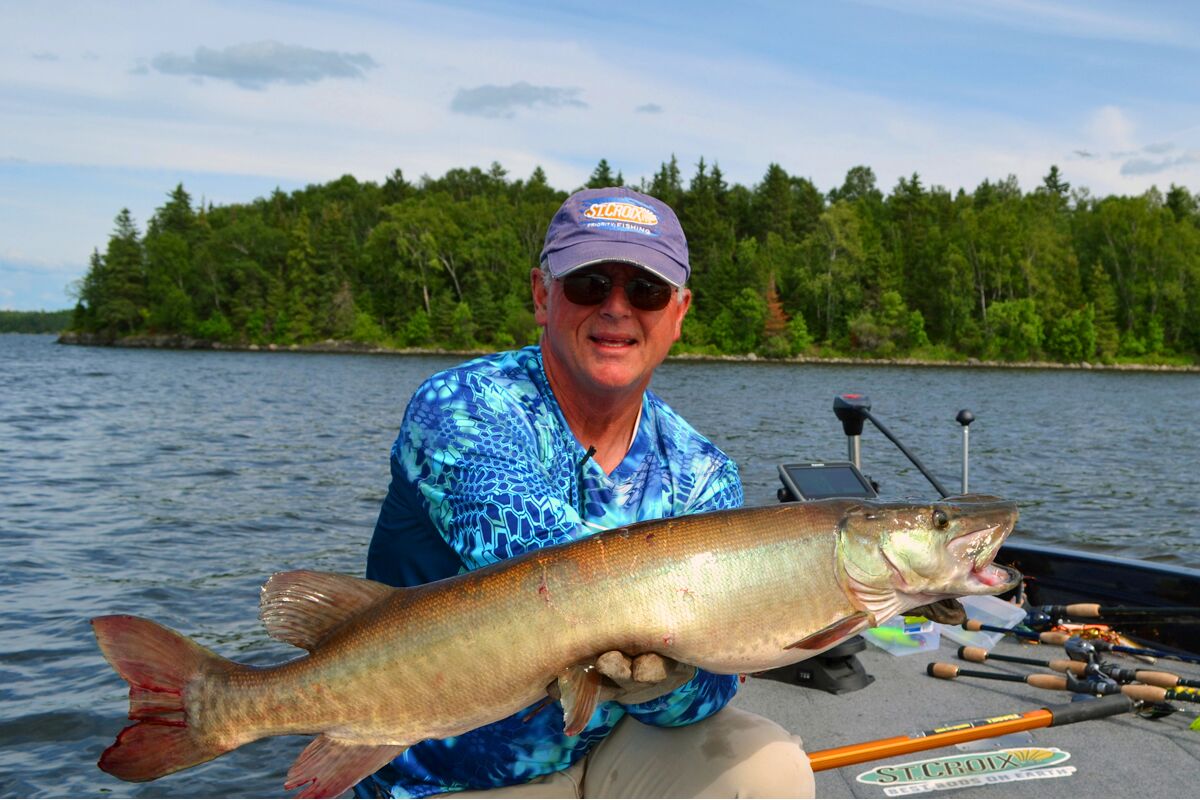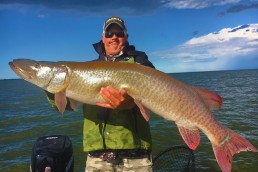Muskie Crankbait Crash Course
SHARE THIS POST
Like an old turntable and a scratchy record that keeps skipping back to the same music lyrics over and over again, crashing crankbaits into cover triggers cold front muskies for me time after time. When conditions turn tough and muskies stop following lures to boatside, the key to success is taking the bait to them. The difference between a fishless day and exuberantly posing for photos with a lunker ’lunge often comes down to your ability to put down traditional tactics and try something different.
When muskies stop following, they are no longer in an aggressive chase mood. It doesn’t matter how many different color versions of the same spinner, topwater or jerkbait your throw. It rarely matters whether the lure is bigger or smaller. They simply aren’t chasing prey. It’s as if they disappeared. Yet, in reality, they are simply hunkered tight to bottom or cover. If you don’t switch up to a presentation that runs a lure much closer to them, you’re probably going home without a bite. Not so surprisingly, many muskie anglers fail to adapt in these situations.

I call this situation a decreasing strike zone. Under more favorable conditions, muskie strike zones can be quite large. An active fish is likely to show interest in anything that lands within sight or sound of its ambush spot, and sometimes even moves toward it to investigate. In many cases, they continue moving with the potential prey all the way to the boat. After a cold front passes, this same fish is most apt to ease in closer to bottom and hunker tighter to cover, showing no interest or effort toward anything outside its immediate area. Hence, it developed a decreased strike zone.
Nothing solves the problem and fits the bill in this situation better than a floating-diving crankbait. Speaking of bill, the diving bill on any typical muskie-style crankbait is one of the keys to success with this entire approach. Not only does the diving bill initiate the wiggle or wobble action of most crankbaits, in this case the diving bill also serves as the contact point with cover and bottom. While most muskie anglers tend to avoid running lures into weeds and debris, I suggest you purposely do this to trigger a response from a reluctant rogue muskie. The diving bill transmits the action of the lure as well as when the bait has collided with some sort of cover or bottom substrate, and telegraphs this info back to you as the line comes through your rod guides.
Theoretically, all this commotion alerts a big predator fish such as a muskie lurking nearby. Once in awhile, this triggers a positive predatory response and the fish simply opens its mouth and snatches up the invader. Suddenly, you go from hours of no action to a doubled rod and wild mad thrashing monster on the end of your line. In other words, strikes are not always explosive, bone jarring events. Instead, all you might feel is a tick or simply sense a sudden bend in the rod.
Are you enjoying this post?
You can be among the first to get the latest info on where to go, what to use and how to use it!
Of course, a floating diver is a prerequisite for this technique. Don’t use lures that sink, suspend or even barely float upwards. Noticeably good buoyancy is a requirement. Some traditional floating diving wood jerkbaits are also bound to work well in some instances for this tactic when muskies hold in shallower areas. I gravitate toward crankbaits over jerkbaits for this tactic, since the natural wobbling action adds more triggering options and crankbaits are far better at triggering followers at boatside with the figure 8 technique.
However, not all floating divers are created equal for this tactic. Hi-impact plastic cranks with built-in diving lips or models with reinforced lip designs of some kind are favored here. The lure’s lip has to hold up to the constant barrage of collisions with hard bottom rocks, gravel, sand and debris. It also must float up a bit tail first to back itself out of rock crevices and debris collection. This is another reason why I prefer floating-diving crankbaits for this tactical application. The diving lip receives most of the punishment, but also collects most of the grass, weeds, leaves, brush and other bottom trash. As soon as you allow the lure to float upwards, most of this debris can clear itself from the lip area. The remaining “clingers” are sure to explode away from the lure with a pronounced sideways or downward rip from your rod. Add a no stretch braided line and a powerful heavy action rod to this equation and you can perfectly execute this technique.
Nothing sells me on a lure or a technique like success. I get particularly excited about it when a lure and technique produce results during a weak bite. When it happens over and over again, I begin to rely on it as the go-to technique when nothing else is working. Always remember, there is no need to crash cranks into bottom when muskies are actively chasing down blades, topwater lures and other free swimming baits. Crashing a crankbait into cover and bottom tends to shine best when those conventional lures and tactics fail. The next time your muskie bite goes sour, crash a crankbait into cover for a few hours and see if this turns your day around. MWO
Visit Joe Bucher’s YouTube channel at fishingwithjoebucher.com. A library of subject-specific videos are available, including one for this article.
When the bite slows or stops, especially after a cold front, try crashing crankbaits into cover and grinding them along bottom to trigger strikes.
MWO
SHARE THIS POST
Did you enjoy this post?
You can be among the first to get the latest info on where to go, what to use and how to use it!
Joe Bucher
Joe Bucher is a Freshwater Fishing Hall of Fame Legendary Angler, book author, lure designer and host of Fishing with Joe Bucher TV series.



